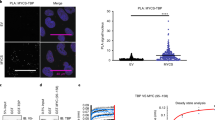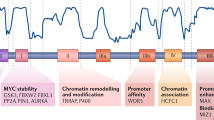Abstract
(A+U)-rich elements (AREs) within 3′ untranslated regions are signals for rapid degradation of messenger RNAs encoding many oncoproteins and cytokines. The ARE-binding protein AUF1 contributes to their degradation. We identified MYC proto-oncogene mRNA as a cellular AUF1 target. Levels of MYC translation and cell proliferation were proportional to AUF1 abundance but inversely proportional to the abundance of the ARE-binding protein TIAR, a MYC translational suppressor. Both AUF1 and TIAR affected MYC translation via the ARE without affecting mRNA abundance. Altering association of one ARE-binding protein with MYC mRNA in vivo reciprocally affected mRNA association with the other protein. Finally, genetic experiments revealed that AUF1 and TIAR control proliferation by a MYC-dependent pathway. Together, these observations suggest a novel regulatory mechanism where tuning the ratios of AUF1 and TIAR bound to MYC mRNA permits dynamic control of MYC translation and cell proliferation.
This is a preview of subscription content, access via your institution
Access options
Subscribe to this journal
Receive 12 print issues and online access
$189.00 per year
only $15.75 per issue
Buy this article
- Purchase on Springer Link
- Instant access to full article PDF
Prices may be subject to local taxes which are calculated during checkout







Similar content being viewed by others
Change history
21 May 2007
fixed y axis of figure 2b
Notes
*NOTE: In the version of this article initially published online, the y-axis label in Figure 2b is incorrect. The correct label should be Luc activity. The error has been corrected for all versions of the article.
References
Tenenbaum, S.A., Carson, C.C., Lager, P.J. & Keene, J.D. Identifying mRNA subsets in messenger ribonucleoprotein complexes by using cDNA arrays. Proc. Natl. Acad. Sci. USA 97, 14085–14090 (2000).
Keene, J.D. & Tenenbaum, S.A. Eukaryotic mRNPs may represent posttranscriptional operons. Mol. Cell 9, 1161–1167 (2002).
Chen, C.Y. & Shyu, A.B. AU-rich elements: characterization and importance in mRNA degradation. Trends Biochem. Sci. 20, 465–470 (1995).
Guhaniyogi, J. & Brewer, G. Regulation of mRNA stability in mammalian cells. Gene 265, 11–23 (2001).
Barreau, C., Paillard, L. & Osborne, H.B. AU-rich elements and associated factors: are there unifying principles? Nucleic Acids Res. 33, 7138–7150 (2005).
Jing, Q. et al. Involvement of microRNA in AU-rich element-mediated mRNA instability. Cell 120, 623–634 (2005).
Raineri, I., Wegmueller, D., Gross, B., Certa, U. & Moroni, C. Roles of AUF1 isoforms, HuR and BRF1 in ARE-dependent mRNA turnover studied by RNA interference. Nucleic Acids Res. 32, 1279–1288 (2004).
Lal, A. et al. Concurrent versus individual binding of HuR and AUF1 to common labile target mRNAs. EMBO J. 23, 3092–3102 (2004).
Wang, W., Martindale, J.L., Yang, X., Chrest, F.J. & Gorospe, M. Increased stability of the p16 mRNA with replicative senescence. EMBO Rep. 6, 158–164 (2005).
Zhang, W. et al. Purification, characterization, and cDNA cloning of an AU-rich element RNA-binding protein, AUF1. Mol. Cell. Biol. 13, 7652–7665 (1993).
Wagner, B.J., DeMaria, C.T., Sun, Y., Wilson, G.M. & Brewer, G. Structure and genomic organization of the human AUF1 gene: alternative pre-mRNA splicing generates four protein isoforms. Genomics 48, 195–202 (1998).
Dempsey, L.A., Li, M.J., DePace, A., Bray-Ward, P. & Maizels, N. The human HNRPD locus maps to 4q21 and encodes a highly conserved protein. Genomics 49, 378–384 (1998).
Sarkar, B., Lu, J.Y. & Schneider, R.J. Nuclear import and export functions in the different isoforms of the AUF1/heterogeneous nuclear ribonucleoprotein protein family. J. Biol. Chem. 278, 20700–20707 (2003).
Chen, C.Y., Xu, N., Zhu, W. & Shyu, A.B. Functional dissection of hnRNP D suggests that nuclear import is required before hnRNP D can modulate mRNA turnover in the cytoplasm. RNA 10, 669–680 (2004).
Laroia, G., Cuesta, R., Brewer, G. & Schneider, R.J. Control of mRNA decay by heat shock-ubiquitin-proteasome pathway. Science 284, 499–502 (1999).
Laroia, G. & Schneider, R.J. Alternate exon insertion controls selective ubiquitination and degradation of different AUF1 protein isoforms. Nucleic Acids Res. 30, 3052–3058 (2002).
Bakheet, T., Frevel, M., Williams, B.R., Greer, W. & Khabar, K.S. ARED: human AU-rich element-containing mRNA database reveals an unexpectedly diverse functional repertoire of encoded proteins. Nucleic Acids Res. 29, 246–254 (2001).
Oster, S.K., Ho, C.S., Soucie, E.L. & Penn, L.Z. The myc oncogene: MarvelouslY Complex. Adv. Cancer Res. 84, 81–154 (2002).
Adhikary, S. & Eilers, M. Transcriptional regulation and transformation by Myc proteins. Nat. Rev. Mol. Cell Biol. 6, 635–645 (2005).
Lozzio, B.B., Lozzio, C.B., Bamberger, E.G. & Feliu, A.S. A multipotential leukemia cell line (K-562) of human origin. Proc. Soc. Exp. Biol. Med. 166, 546–550 (1981).
DeMaria, C.T. & Brewer, G. AUF1 binding affinity to A+U-rich elements correlates with rapid mRNA degradation. J. Biol. Chem. 271, 12179–12184 (1996).
DeMaria, C.T., Sun, Y., Long, L., Wagner, B.J. & Brewer, G. Structural determinants in AUF1 required for high affinity binding to A + U-rich elements. J. Biol. Chem. 272, 27635–27643 (1997).
Brewer, G. An A+U-rich element RNA-binding factor regulates c-myc mRNA stability in vitro. Mol. Cell. Biol. 11, 2460–2466 (1991).
Lal, A. et al. Posttranscriptional derepression of GADD45alpha by genotoxic stress. Mol. Cell 22, 117–128 (2006).
Pioli, P.A., Hamilton, B.J., Connolly, J.E., Brewer, G. & Rigby, W.F.C. Lactate dehydrogenase is an AU-rich element-binding protein that directly interacts with AUF1. J. Biol. Chem. 277, 35738–35745 (2002).
Kedersha, N.L., Gupta, M., Li, W., Miller, I. & Anderson, P. RNA-binding proteins TIA-1 and TIAR link the phosphorylation of eIF-2{alpha} to the assembly of mammalian stress granules. J. Cell Biol. 147, 1431–1442 (1999).
Mazan-Mamczarz, K., Lal, A., Martindale, J.L., Kawai, T. & Gorospe, M. Translational repression by RNA-binding protein TIAR. Mol. Cell. Biol. 26, 2716–2727 (2006).
Lu, J.Y., Bergman, N., Sadri, N. & Schneider, R.J. Assembly of AUF1 with eIF4G-poly(A) binding protein complex suggests a translation function in AU-rich mRNA decay. RNA 12, 883–893 (2006).
Culjkovic, B., Topisirovic, I., Skrabanek, L., Ruiz-Gutierrez, M. & Borden, K.L. eIF4E is a central node of an RNA regulon that governs cellular proliferation. J. Cell Biol. 175, 415–426 (2006).
Hann, S.R., King, M.W., Bentley, D.L., Anderson, C.W. & Eisenman, R.N. A non-AUG translational initiation in c-myc exon 1 generates an N-terminally distinct protein whose synthesis is disrupted in Burkitt's lymphomas. Cell 52, 185–195 (1988).
Spotts, G.D., Patel, S.V., Xiao, Q. & Hann, S.R. Identification of downstream-initiated c-Myc proteins which are dominant-negative inhibitors of transactivation by full-length c-Myc proteins. Mol. Cell. Biol. 17, 1459–1468 (1997).
Nanbru, C. et al. Alternative translation of the proto-oncogene c-myc by an internal ribosome entry site. J. Biol. Chem. 272, 32061–32066 (1997).
Groisman, I. et al. Control of cellular senescence by CPEB. Genes Dev. 20, 2701–2712 (2006).
Chen, C.Y. & Shyu, A.B. Selective degradation of early-response-gene mRNAs: functional analyses of sequence features of the AU-rich elements. Mol. Cell. Biol. 14, 8471–8482 (1994).
Bernstein, P.L., Herrick, D.J., Prokipcak, R.D. & Ross, J. Control of c-myc mRNA half-life in vitro by a protein capable of binding to a coding region stability determinant. Genes Dev. 6, 642–654 (1992).
Wisdom, R. & Lee, W. The protein-coding region of c-myc mRNA contains a sequence that specifies rapid mRNA turnover and induction by protein synthesis inhibitors. Genes Dev. 5, 232–243 (1991).
Vervoorts, J., Luscher-Firzlaff, J. & Luscher, B. The ins and outs of MYC regulation by posttranslational mechanisms. J. Biol. Chem. 281, 34725–34729 (2006).
Lu, J.Y., Sadri, N. & Schneider, R.J. Endotoxic shock in AUF1 knockout mice mediated by failure to degrade proinflammatory cytokine mRNAs. Genes Dev. 20, 3174–3184 (2006).
Langa, F. et al. Healthy mice with an altered c-myc gene: role of the 3′ untranslated region revisited. Oncogene 20, 4344–4353 (2001).
Gouble, A. & Morello, D. Synchronous and regulated expression of two AU-binding proteins, AUF1 and HuR, throughout murine development. Oncogene 19, 5377–5384 (2000).
Beck, A.R., Medley, Q.G., O'Brien, S., Anderson, P. & Streuli, M. Structure, tissue distribution and genomic organization of the murine RRM-type RNA binding proteins TIA-1 and TIAR. Nucleic Acids Res. 24, 3829–3835 (1996).
Wilson, G.M. et al. Regulation of A + U-rich element-directed mRNA turnover involving reversible phosphorylation of AUF1. J. Biol. Chem. 278, 33029–33038 (2003).
Wilson, G.M. et al. Phosphorylation of p40AUF1 regulates binding to A + U-rich mRNA-destabilizing elements and protein-induced changes in ribonucleoprotein structure. J. Biol. Chem. 278, 33039–33048 (2003).
He, C. & Schneider, R. 14–3-3sigma is a p37 AUF1-binding protein that facilitates AUF1 transport and AU-rich mRNA decay. EMBO J. 25, 3823–3831 (2006).
Fawal, M. et al. A “liaison dangereuse” between AUF1/hnRNPD and the oncogenic tyrosine kinase NPM-ALK. Blood 108, 2780–2788 (2006).
Delgado, M.D., Lerga, A., Canelles, M., Gomez-Casares, M.T. & Leon, J. Differential regulation of Max and role of c-Myc during erythroid and myelomonocytic differentiation of K562 cells. Oncogene 10, 1659–1665 (1995).
Williams, N.S. et al. Identification and validation of genes involved in the pathogenesis of colorectal cancer using cDNA microarrays and RNA interference. Clin. Cancer Res. 9, 931–946 (2003).
Liao, B. et al. Targeted knockdown of the RNA-binding protein CRD-BP promotes cell proliferation via an insulin-like growth factor II-dependent pathway in human K562 leukemia cells. J. Biol. Chem. 279, 48716–48724 (2004).
Liao, B., Hu, Y., Herrick, D.J. & Brewer, G. The RNA-binding protein IMP-3 is a translational activator of insulin-like growth factor II leader-3 mRNA during proliferation of human K562 leukemia cells. J. Biol. Chem. 280, 18517–18524 (2005).
Kawai, T. et al. Translational control of cytochrome c by RNA-binding proteins TIA-1 and HuR. Mol. Cell. Biol. 26, 3295–3307 (2006).
Acknowledgements
We thank M. Gorospe (National Institute on Aging, US National Institutes of Health) for providing TIAR siRNA and the polyribosome gradient procedure; M. Gorospe, N. Kedersha and P. Anderson (Harvard Medical School) for plasmids pMT2 and pMT2-HA-TIAR; J. Leon (Universidad de Cantabria) for cell lines KmycB and KmycJ; and S. Gross and T. Kinzy (Robert Wood Johnson Medical School) for technical assistance with the polyribosome gradient experiments. This work was supported by US National Institutes of Health grant CA052443 to G.B.
Author information
Authors and Affiliations
Contributions
B.L. designed and performed experiments, interpreted experimental data and wrote the paper. Y.H. performed experiments. G.B. designed experiments, interpreted experimental data and wrote the paper. All authors approved the final version of the paper.
Corresponding author
Ethics declarations
Competing interests
The authors declare no competing financial interests.
Supplementary information
Supplementary Fig. 1
Antibody specific for AUF1 precipitates MYC mRNA from cytoplasmic lysates of K562 cells (PDF 68 kb)
Supplementary Fig. 2
Effects of AUF1 knockdown on MYC gene expression in HeLa cells (PDF 3620 kb)
Supplementary Fig. 3
Effects of AUF1 knockdown on luciferase-MYC ARE reporter gene expression in HeLa cells (PDF 799 kb)
Supplementary Fig. 4
TIAR antibody precipitates MYC ARE reporter mRNA but not luciferase mRNA lacking the ARE (PDF 720 kb)
Supplementary Fig. 5
TIAR knockdown has no effect on MYC mRNA levels in K562 cells (PDF 780 kb)
Supplementary Fig. 6
Effects of TIAR knockdown on luciferase–MYC ARE reporter gene expression with in K562 cells (PDF 822 kb)
Supplementary Fig. 7
Controls for mRNP immunoprecipitations following AUF1 and TIAR knockdown (PDF 833 kb)
Supplementary Fig. 8
AUF1 knockdown retards proliferation of HeLa cells (PDF 54 kb)
Supplementary Fig. 9
TIAR knockdown reverses the cellular proliferation defect conferred by AUF1 knockdown (PDF 55 kb)
Supplementary Fig. 10
MYC knockdown reverses the proliferation-inducing effects of TIAR knockdown (PDF 157 kb)
Rights and permissions
About this article
Cite this article
Liao, B., Hu, Y. & Brewer, G. Competitive binding of AUF1 and TIAR to MYC mRNA controls its translation. Nat Struct Mol Biol 14, 511–518 (2007). https://doi.org/10.1038/nsmb1249
Received:
Accepted:
Published:
Issue Date:
DOI: https://doi.org/10.1038/nsmb1249
This article is cited by
-
Ascites exosomal lncRNA PLADE enhances platinum sensitivity by inducing R-loops in ovarian cancer
Oncogene (2024)
-
In vivo PAR-CLIP (viP-CLIP) of liver TIAL1 unveils targets regulating cholesterol synthesis and secretion
Nature Communications (2023)
-
The RNA binding proteins TIA1 and TIAL1 promote Mcl1 mRNA translation to protect germinal center responses from apoptosis
Cellular & Molecular Immunology (2023)
-
ARE-mediated decay controls gene expression and cellular metabolism upon oxygen variations
Scientific Reports (2018)
-
miR-19a promotes colorectal cancer proliferation and migration by targeting TIA1
Molecular Cancer (2017)



